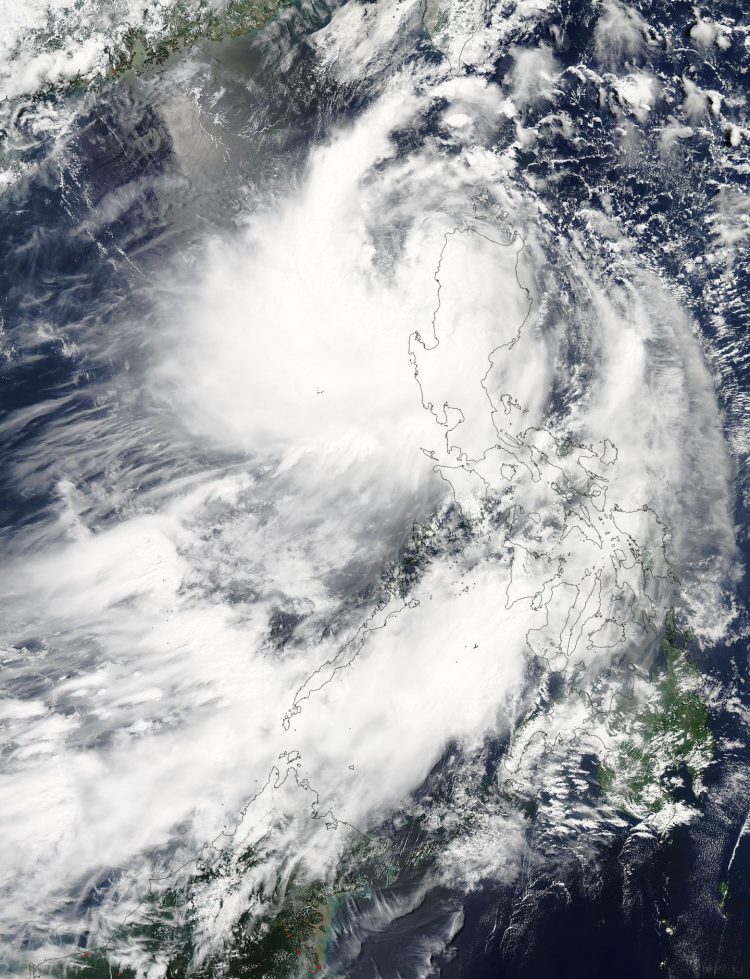NASA sees Tropical Storm Linfa exiting northern Philippines

On July 5 at 05:25 UTC (1:25 a.m. EDT) the MODIS instrument aboard NASA's Aqua satellite captured this image or Tropical Storm Linfa moving into the South China Sea. Credits: NASA Goddard MODIS Rapid Response Team
On July 5 at 05:25 UTC (1:25 a.m. EDT) the MODIS (Moderate Resolution Imaging Spectroradiometer) instrument aboard NASA's Aqua satellite captured a visible image or Tropical Storm Linfa moving into the South China Sea.
The storm appeared to be somewhat elongated because of wind shear and had weakened as a result of moving over land. MODIS imagery also showed an isolated area of deep convection, thunderstorms and clouds, pushed over the southwest quadrant of the low-level center, as a result of northeasterly wind shear.
The Joint Typhoon Warning Center noted that animated multispectral satellite imagery showed that the low-level center of circulation is exposed to outside winds.
Tropical Storm Linfa was about 295 nautical miles (339 miles/1,639 km) north-northwest of Manila, Philippines. It was centered near 19.2 North latitude and 119.2 East longitude. Tropical Storm Linfa has maximum sustained winds near 45 knots (51.7 mph/83.3 kph). It was moving to the north at 5 knots (5.7 mph/9.6 kph).
As Linfa continues to exit the northern Philippines, some warnings remained in effect for July 5. Public storm warning signal #2 remained in effect in the Luzon provinces of Batanes, Cagayan including Calayan and Babuyan group of Islands, Apayao, Kalinga, Ilocos Norte, Ilocos Sur and Abra. In addition Public storm warning signal #1 remained in effect in the Luzon provinces of Pangasinan, Isabela, Benguet, La Union, Mt. Province and Ifugao.
Linfa is moving north and is forecast to then curve northwest and move between Taiwan and mainland China by July 9. The Joint Typhoon Warning Center expects Linfa to strengthen a little before wind shear brings about its dissipation in the Taiwan Strait sometime around July 10.
Media Contact
All latest news from the category: Earth Sciences
Earth Sciences (also referred to as Geosciences), which deals with basic issues surrounding our planet, plays a vital role in the area of energy and raw materials supply.
Earth Sciences comprises subjects such as geology, geography, geological informatics, paleontology, mineralogy, petrography, crystallography, geophysics, geodesy, glaciology, cartography, photogrammetry, meteorology and seismology, early-warning systems, earthquake research and polar research.
Newest articles

Recovering phosphorus from sewage sludge ash
Chemical and heat treatment of sewage sludge can recover phosphorus in a process that could help address the problem of diminishing supplies of phosphorus ores. Valuable supplies of phosphorus could…

Efficient, sustainable and cost-effective hybrid energy storage system for modern power grids
EU project HyFlow: Over three years of research, the consortium of the EU project HyFlow has successfully developed a highly efficient, sustainable, and cost-effective hybrid energy storage system (HESS) that…

After 25 years, researchers uncover genetic cause of rare neurological disease
Some families call it a trial of faith. Others just call it a curse. The progressive neurological disease known as spinocerebellar ataxia 4 (SCA4) is a rare condition, but its…





















